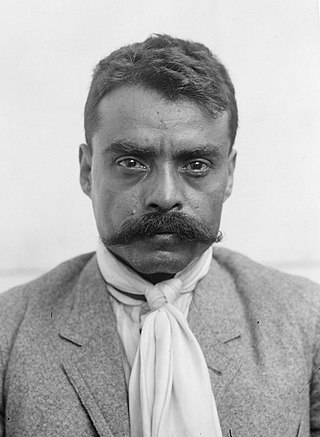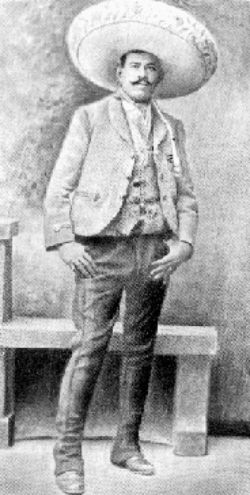
Emiliano Zapata Salazar was a Mexican revolutionary. He was a leading figure in the Mexican Revolution of 1910–1920, the main leader of the people's revolution in the Mexican state of Morelos, and the inspiration of the agrarian movement called Zapatismo.

Viva Zapata! is a 1952 American Western film directed by Elia Kazan and starring Marlon Brando. The screenplay was written by John Steinbeck, using Edgcomb Pinchon's 1941 book Zapata the Unconquerable as a guide. The cast includes Jean Peters, and in an Academy Award-winning performance, Anthony Quinn.

Zapata: el sueño del héroe, also titled simply Zapata, is a 2004 Mexican film.
Ciudad Ayala is a city in the east-central part of the Mexican state of Morelos. It stands at 18°45′59″N98°59′05″W, at a mean height of 1,220 m (4,000 ft) above sea level. The city is named for Coronel Francisco Ayala (1760-1812) who fought with José María Morelos during the 1812 Siege of Cuautla. The town's previous name was Mapachtlan. Ayala became a municipality on April 17, 1869.

The Plan of Ayala was a document drafted by revolutionary leader Emiliano Zapata during the Mexican Revolution. In it, Zapata denounced President Francisco Madero for his perceived betrayal of the revolutionary ideals embodied in Madero's Plan de San Luis Potosí, and set out his vision of land reform. The Plan was first proclaimed on November 28, 1911 in the town of Ayala, Morelos, and was later amended on June 19, 1914. The Plan of Ayala was a key document during the revolution and influenced land reform in Mexico during the 1920s and 1930s. It was the fundamental text of the Zapatistas.

The Liberation Army of the South was a guerrilla force led for most of its existence by Emiliano Zapata that took part in the Mexican Revolution from 1911 to 1920. During that time, the Zapatistas fought against the national governments of Porfirio Díaz, Francisco Madero, Victoriano Huerta, and Venustiano Carranza. Their goal was rural land reform, specifically reclaiming communal lands stolen by hacendados in the period before the revolution. Although rarely active outside their base in Morelos, they allied with Pancho Villa to support the Conventionists against the Carrancistas. After Villa's defeat, the Zapatistas remained in open rebellion. It was only after Zapata's 1919 assassination and the overthrow of the Carranza government that Zapata's successor, Gildardo Magaña, negotiated peace with President Álvaro Obregón.

Genovevo de la O was an important figure in the Mexican Revolution in Morelos.
Sidronio Camacho was one of the soldiers of Emiliano Zapata during the Mexican Revolution and the killer of Emiliano's brother, Eufemio.

References and depictions of Mexican revolutionary Emiliano Zapata, places and things named for and commemorating him.

Felipe Neri was a soldier and general in the Mexican Revolution.

Amador Salazar Jiménez was a Mexican military leader who participated in the Mexican Revolution.

The Treaty of Ciudad Juárez was a peace treaty signed between the President of Mexico, Porfirio Díaz, and the revolutionary Francisco Madero on May 21, 1911. The treaty put an end to the fighting between forces supporting Madero and those of Díaz and thus concluded the initial phase of the Mexican Revolution.

The Battle of Cuautla was a battle between the forces of Emiliano Zapata and the federal army of the Mexican government that took place in the state of Morelos from May 11–19, 1911, during the Mexican Revolution. It has sometimes been described as "six of the most terrible days of battle in the whole Revolution". Eventually, the remains of the defending "Golden Fifth" regiment, the Fifth Cavalry Regiment of the Federal Army, withdrew and Zapata took control of the town. The Zapatista victory convinced Porfirio Díaz to come to terms with Francisco Madero, agree to the Treaty of Ciudad Juárez and resign as president.

Otilio Montaño Sánchez was a Zapatista general during the Mexican Revolution.

Pablo González Garza was a general during the Mexican Revolution. He is considered to be the main organizer of the assassination of Emiliano Zapata.

Jesús Salgado was a revolutionary leader and soldier in the Mexican Revolution, sometimes called the "Guerrero Zapata". He initially supported Francisco Madero but in 1911 threw his support behind Emiliano Zapata and remained loyal to the Zapatista cause until his death in 1919.
Events in the year 1917 in Mexico.
The Battle of Parque was a battle during the Mexican Revolution, where Emiliano Zapata and his supporters rebelling against president Francisco I. Madero, who had recently overthrown the previous president Porfirio Díaz. A group of Zapata's supporters attempted to ambush a train containing 27 Mexican Rurales under the command of the American Soldier of Fortune, Emil Lewis Holmdahl.
The Battle of Cuernavaca was a battle during the Mexican Revolution, where Emiliano Zapata and his supporters rebelling against president Francisco I. Madero, who had recently overthrown the previous president Porfirio Díaz. Zapata was patrolling around his stronghold in the hills of Cuernavaca, where he was ambushed by a government force of Rurales under the command of the American Soldier of Fortune, Emil Lewis Holmdahl.












